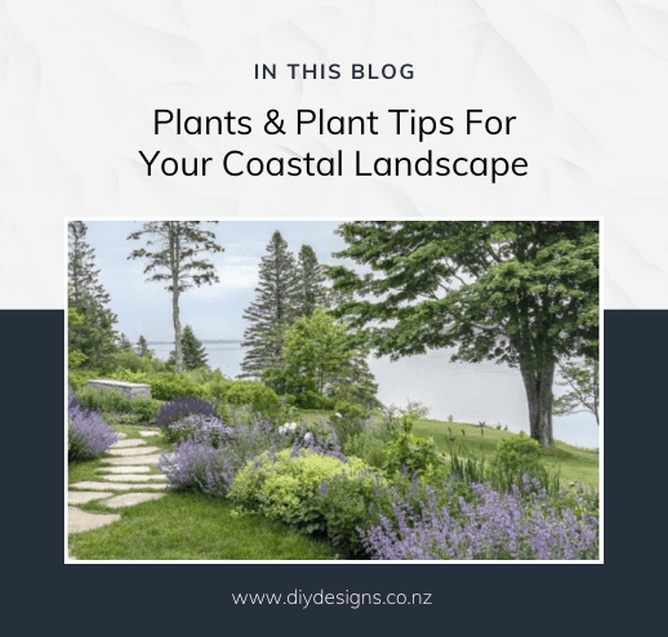Auckland - Landscape Design for Coastal Gardens
Auckland landscape design forms a large body of the design work we do here at DIY Designs, so our projects often involve the creation of tough planting schemes that will survive the challenges of a coastal setting.
Our previous blog on coastal gardens focussed on suggestions for landscape trees, shrubs and hedges to use in a coastal landscape design, in the temperate Auckland region. In this follow-up blog, the focus is on lower-growing plants, such as small shrubs and groundcovers.
COASTAL CONDITIONS TO CONSIDER
There are four key factors that have to be considered in the design of a plant palette for a coastal garden :
Coastal landscapes are exposed to strong, salt-laden winds.
Soils tend to be thin sandy and very fast-draining
To preserve those stunning Auckland harbour or sea views, plantings are often kept low to the ground. This contributes to a lack of shade which in turn results in sun-drenched beds that are often incredibly dry.
In Auckland landscape design projects, choosing plants that are also well-suited to the humid climate of the region is vital to a successful outcome.
Add those conditions up and it makes for a challenging set of growing conditions.
If you are planning your own landscape design, or for those that like to wing it, hitting one of the many Auckland garden centres or nurseries without a landscape design plan in hand, there are plenty of amenity landscape plants that are well suited to such conditions. Fortunately, these plants have helpfully evolved to have a few obvious visual characteristics that can help you identify them.
HOW TO IDENTIFY PLANTS SUITABLE FOR COASTAL GARDENS
1. Silver or glaucous (blue-green) toned foliage.
Silver or glaucous (blue-green) foliage is a good indicator that a plant is drought tolerant. You'll learn why in point 2.
2. Furry Leaves
The tactile amongst us love to stroke the furry leaves that a lot of plants have. This furry coating, often on the undersides of the leaves, is created by very fine hairs and is known as 'tomentosum'. Tomentosum provides a layer of protection from salt-laden winds. It is often the tomentosum (fine hairs) that can give plants the silvery foliage described above.
3. Shiny/ Waxy Leaves
Not just pretty to look at, those glossy plant leaves we all ooh and ahh over are also providing a protective measure against the elements. How? Plants with shiny leaves have a waxy coating. This gives protection against certain environmental factors (such as salt and wind) by creating a barrier, and can help the plant retain moisture in hot environments as the coatings can help deflect the rays of the sun, stopping the plant from transpiring too quickly. That’s why these thick leaves are also often moisture-filled.
SO, WHAT TO PLANT?
If you have a preference for NZ natives. Arthropodium, commonly called rengarenga lily, is a great colonising ground cover for sun and shade, and it will cope with dry coastal conditions. With its wide grey-green leaves and attractive white flowers Arthropodium ‘Matapouri Bay’ is my favourite, followed by the finer foliaged form of Arthropodium ‘Parnell’.
Silver flax-like Astelias are another great option for dry areas (sun or shade). Astelia chathamica has the wide, pale silver leaves while Astelia banksii has a narrower, slightly greener leaf. Auckland coastal landscape design and Pohutukawa go hand in hand and as anyone who has ever tried to grow plants beneath one of these will tell you, it’s a tough, dry spot. Astelia (and arthropodium) make some of the best choices for underplanting pohutukawa or other large coastal trees.
In sunnier, more open coastal garden positions, silver-toned Westringia (Australian box / Australian rosemary) is a useful plant family to get familiar with. Be it for hedges, free-form shrubs, mounds, clipped formal balls or a massed groundcover, there’s bound to be a suitable-sized cultivar bred specifically for your desired purpose. Westringia requires a lot less clipping than Teucrium fruticans, another popular coastal plant which has similar applications.
Also known as 'silver germander', Teucrium fruticans is a vigorous grower and great for fast effects. But, unless you are prepared to clip it regularly, it is better suited to the larger garden setting, where it will have room to spread.
Lavender looks very at home in a coastal setting and are ideal plants if you want to attract bees to your garden. Lavender 'Fouveaux Storm' is a good lavender choice for the Auckland climate, but should still be seen as a relatively short-lived option.
If you are looking for something less predictable and more reliable, in my Auckland landscape design projects I’ve been using a lot of Salvia leucanthe, which gives a fuss-free lavender-like effect. I also like to use the open and airy form of Verbena boniariensis, another purple flowering plant which flowers over a long period.
Rosemary is a bulletproof option for coastal gardens and (like lavender) is ideal if you want to attract bees to your garden.
Osteospermum (cape daisy) is the perfect choice for flower lovers and another great choice for the bee garden. Similar free-flowering coastal daisy options include Arctotis and Gazania - confusingly similar and both commonly known as African daisy.
If you're more foliage-oriented than flowers NZ native Euphorbia glauca is an easy-to-grow, colonising perennial that is very at home in coastal conditions.
Blue-green grass-like lomandra such as Lomandra 'Frosty Tops' and Lomandra 'Nyalla' will add contrast and texture to any coastal scheme. While not native these Aussies are very reliable additions to the coastal plant palette, often performing better than our NZ native grasses which are more suited to alpine conditions.
NZ native plant lovers, don't worry, a huge range of options for size and colour and leaf form can be found in the coprosma family. This plant family includes shrubs, hedges and one my favourite sprawling groundcover Coprosma repens ‘Poor Knights’. Smaller cultivars such as Coprosma 'Lighthouse' and Coprosma 'Mini Mac' are ideal for small garden areas. These are aptly known as ‘mirror plants’ due to their very glossy leaves. Coprosmas are great for sprawling or scrambling over sunny slopes and covering large areas.
The coprosma family also includes smaller leaf types such as Coprosma Taiko’ and Coprosma ‘Kirkii’. These have a low habit and smaller, needle-like leaves which are still thick and glossy, so well suited to use in a coastal landscape design. With coverage of up to 3m + for some cultivars, spreading plants are a godsend to the gardener on a tight budget.
The super-popular star jasmine ‘Trachelospermum jasminoides’ is ideal either pinned and clipped as a groundcover, or given support and grown as a climbing plant.
If you prefer a native climber, look no further than Tecomanthe speciosa (Three Kings climber). A vigorous grower with thick, glossy leaves and large, interesting, creamy-green flowers.
The above list is by no means exhaustive but does show that there is an abundance of easy-to-grow plants which are suitable to your coastal landscape design, and with their helpful visual clues they are easy to spot, even for the novice gardener.
If you are looking for professional help with your Auckland or other NZ coastal landscape design, get in touch. We’d love to help you and can put together a plant palette ideal for your coastal garden.
DIY Designs are an Auckland-based landscape design company. Located in Titirangi, West Auckland we work online providing a range of affordable fixed-price landscape and planting plans to help get your garden transformation underway.

